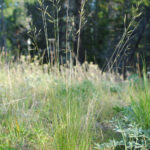Idaho Fescue
Festuca idahoensis
General Description
Idaho fescue is a densely tufted, native perennial bunchgrass. It is an important component of late successional upper grassland plant communities in southern British Columbia and is common throughout the U.S. Pacific Northwest. The recognition of Idaho fescue as a separate species is questioned by some authors, who consider it a variety of Festuca occidentalis (western fescue). However, it is closely related to the Festuca ovina complex and has long been identified as a separate species.
Type
Native grass.
Origin
Western North America.
Longevity
Idaho fescue is long-lived.
Use
Reclamation, grazing. Idaho fescue is an important forage for livestock and native ungulates. It has some potential for rehabilitation and erosion control.
Optimal Time of Use
Idaho fescue can be grazed in all seasons. Most of its growth occurs in spring, but it cures well and is palatable to cattle and native ungulates well into fall. It is not preferred by sheep once it matures.
Recovery After Use
Idaho fescue can withstand grazing of up to 50% of its annual production, but it should not be grazed at the same time each year. It should not be grazed closer than 8 cm (3 in) to the ground. Complete rest every 2-4 years, or a lower level of utilization (30%) will help maintain vigour and range condition.
Forage production from the “Joseph” Idaho fescue cultivar was found to be greater than other fine fescues (e.g., “Durar” hard fescue and “Cascade” Chewing’s red fescue).
Palatability/Nutritional Value
Idaho fescue is considered excellent forage for cattle and good forage for sheep, maintains its forage value late into the season, and is good forage for native ungulates in winter.
Annual Precipitation min/max (mm)
305mm / 510mm
Drought Tolerance
Moderate drought tolerance. Idaho fescue is noted to have drought tolerance similar to that of hard fescue.
Flooding Tolerance
Idaho fescue is intolerant of flooding.
Winter Hardiness
High winter hardiness.
Soil Texture Preference
Prefers silt loam or sandy loam soils.
Erosion Control
Extensive root system makes it suitable for erosion control once established.
Salinity Tolerance
Low tolerance, tolerates weakly saline conditions.
Acidity Tolerance
Low to moderate tolerance, tolerates pH down to 5.6.
Alkalinity Tolerance
Low to moderate, tolerates alkaline conditions up to pH 8.4.
Seeds per kg
192,777 – 208,652 seeds/kg (425,000 – 460,000 seeds/lb)
Suggested Mixtures
Normally recommended as a component in seed mixtures with other native species.
Ease of Establishment
Idaho fescue can be difficult to establish and requires 2–3 years to reach a mature stand phase. Germination can be variable, especially with native seed collections. Two cultivars of Idaho fescue (Joseph and Nezpurs) have been developed at the University of Idaho using 3 phases of phenotypic recurrent selection. The population base for the cultivars came from 89 native ecotypes collected from the northwestern U.S. and Canada. Both exhibit better germination and establishment characteristics than the source collections. Germination will be enhanced with drill seeding, but this may not be practical or desirable depending on the context. Late fall seeding is recommended.
Competitiveness
Moderately competitive once established. Does not compete well with aggressive introduced grasses.
Management Considerations
Idaho fescue decreases with overgrazing. Deferred grazing is beneficial for maintaining Idaho fescue and can provide late fall and winter forage for wildlife.
BC Rangeland Seeding Manual, USDA Plants Database
Idaho fescue is common in native grassland communities in the Southern Interior, and is suited for dryland range, restoration and reclamation at upper elevations in the Bunchgrass zone, and in the Ponderosa Pine and Interior Douglas-fir zones.
